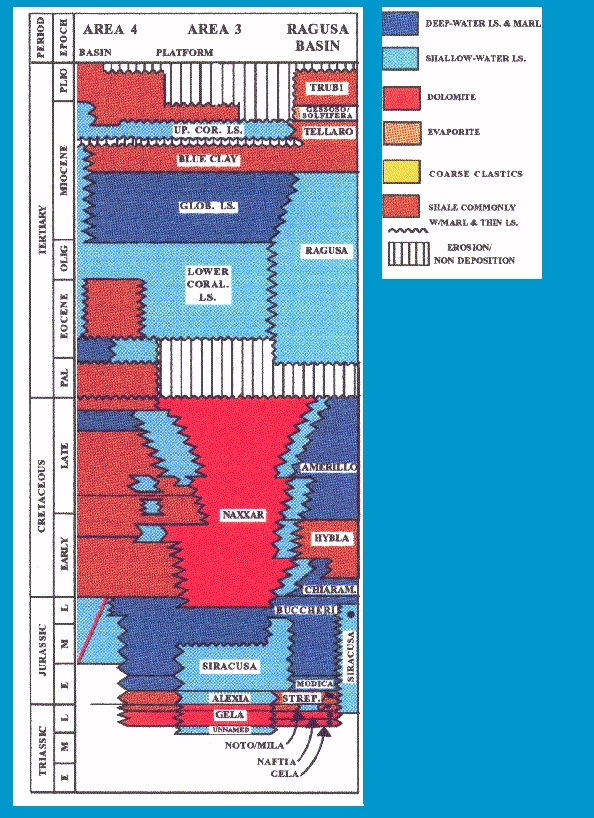
A review of the geographical evolution of the region of the Maltese Islands during the various geological periods suggests that the region has been one of a continued carbonate sedimentation for a considerable period prior to the Miocene (Table 1).
TABLE 1: PRE-MIOCENE EVOLUTION
|
|
million years |
|
| Oligocene |
|
|
| Eocene |
|
|
| Cretaceous |
|
in Valendian or Albian Series |
| Jurassic |
|
|
| Triassic |
|
|
| Permian |
|
|
| Carboniferous |
|
Development of foredeep; Tethys assumes ultimate shape until Triassic. |
| Devonian |
|
|
| Silurian |
|
|
| Ordovician |
|
|
| Cambrian |
|
|
| Pre-Cambrian |
|
|
The carbonate deposition series was confirmed by the geological results obtained from the 3000 metre deep borehole sunk by the British Petroleum Co. Ltd., at Naxxar (4974) Malta in 1959. The uppermost Lower Coralline Limestone was followed by a series of shelly limestones and subordinate shales to a depth of 650m, these being referable to the Oligocene. The Eocene and Cretaceous series of rocks belonged to dolomitized limestones (Naxxar Limestone series). At a depth of 3000m, the dolomites carried spores which had a Lower Cretaceous affinity. Further boreholes dug offshore in the territorial waters of the Maltese Islands, particularly Area 3, have further elucidated the pre-Miocene stratigraphy of the region, extending the stratigraphical data to the Late Triassic. The Cretaceous dolomitic series continues into the Late Jurassic, and is then followed by limestone/marl deposited in deep waters until the Middle Jurassic. This is again replaced by shallow-water limestone of two varieties (named Siracusa and Alexia). The Late Triassic is characterised by dolomitic limestone (Gela limestone) overlying a shallow-water limestone deposit. The results of the borehole dug at Kercem Gozo in 1998-99 should further elucidate the earlier stratification.

The Pre-Miocene Stratigraphy has been determined mainly from well dug for the purposes of petroleum exploration either on shore or off shore.
Four distinct Upper Triassic-Jurassic paleaogeographic domains can be recognized in offshore Malta, a strongly subsiding one characterised by basinal facies of the Noto, Streppenosa, Modica, Buccheri, Chiaramonte, Hybla and Amerillo Formations, a stable one characterised by shallow open to restriced water facies of the Siracusa and Naxxar Formations, an intermadiate domain characterised by open marine facies of the Siracusa-Buccheri combination and an evaporitic domain of the Krachoua Formation.
Proven source rocks of Upper Triassic and Lower Jurassic Noto and Streppenosa Formations were deposited in the basins. These formations are known to source the oil in the Ragusa Basin which extends into Blocks 1, 2, 3, 4 and 5 of Area 3 in the north.
A similar situation is inferred in the south-eastern parts of Area 4 where Jurassic faulting is observed along a NNW-SSE trend cutting through Blocks 5 and 7. Facies differentiation culminated in the Late Cretaceous. Three similar domains developed in regions covered by Area 4 and to the west of it: a platform domain characterised by a monotonic sequence of dolomites and limestones of the Zebbag and Halk el Menzel Formations drilled in Tama-1, an intermediate domain with rudist buildups observed on the shelf edge of the Melita Rise drilled offshore Tunisia (Isis field), and a third domain characterised by Zebbag dolomites overlain by a thick sequence of organic rich shales and limestones of the Fahdene, Bahloul, Aleg el Haria and Bou Dabbous Formation.
Transitional Cretaceous facies are present in GOZ and AQ indicating the Malta Platform limit to be close to these wells. GOZ which was suspended in the Early Cretaceous encountered a thick section of Hybla shales overlain by chalks which are reminiscent of the Abiod Formation in Tunisia. These chalks have also been encountered in AQ. Beds of porous, intertidal dolomite and shelf-edge calcarenite, altering with impermeable marl, mudstone and shale, are inferred to occur in the Cretaceous transition zone, providing good reservoirs and seal potential. Rudist-reef reservoirs, present in offshore Tunisia may extend into parts of Area 4. Cretaceous source rocks, equivalent to the Bahloul and Fahdene are also inferred to be present in this zone.
A very striking fourth domain is recognised in the western half west of Area 4. Geological and geophysical data indicate that the tectono-sedimentary history of the area followed the same pattern observed in nearby basins with important local salt movements. One observes on seismic sections a central broad structural high with thinning of the overlying Late Cretaceous sedimentary sequence as well as a rim syncline also of Late Cretaceous age. Towards the end of the Cretaceous salt activity appears to have been damped and basin inversion occurred.
Palaeocene and Lower Eocene Metlaoui reservoirs of offshore Tunisia may also be present in Area 4 and to the west of it. A shelf-edge carbonate build-up recognized on seismic sections in west of Area 4 is interpreted in this sense. An equivalent of the Bou Dabbous Formation, source rock to nearby Ashtart and Bouri fields, should be present.
Post-Eocene age Lower Coralline Limestone, Globigerina Limestone, Blue Clay and Upper Coralline Limestone are widespread. They have been encountered in all wells including MB and TAM.
Mudstone and claystone with abundant planktonic foraminiferids of Pliocene-Quaternary age, encountered in AQ, are present in the troughs of the Sicily-Channel rift complex and other subsiding areas. The thickness of these sediments is controlled by post-Miocene rifting, about 340m at the downthrown AQ and one metre at the upthrown MB. As much as 2,000m are estimated to be present in the deep troughs.